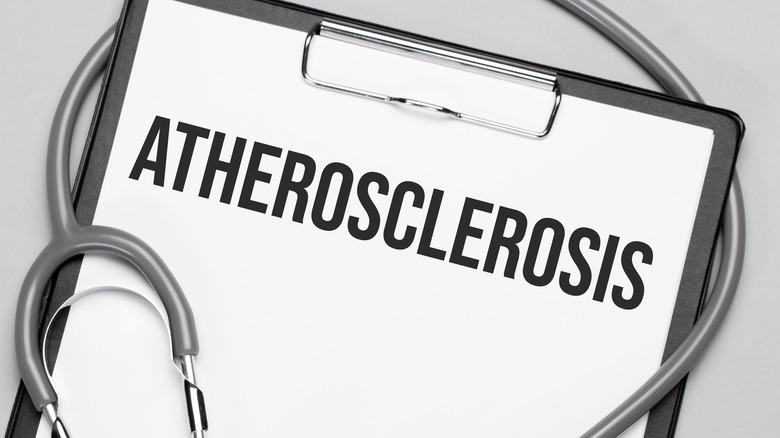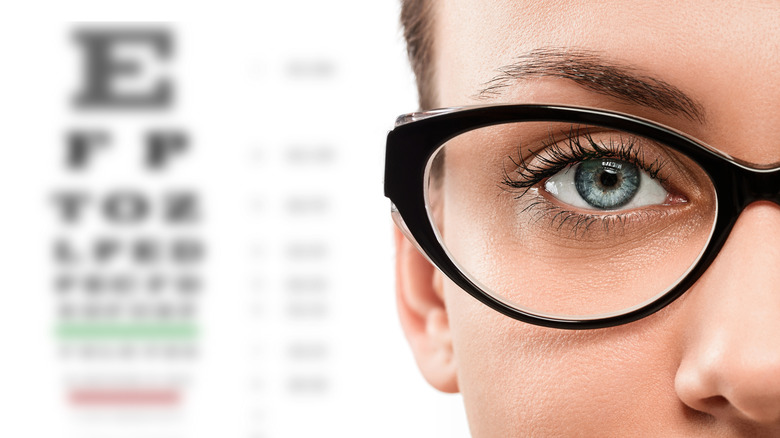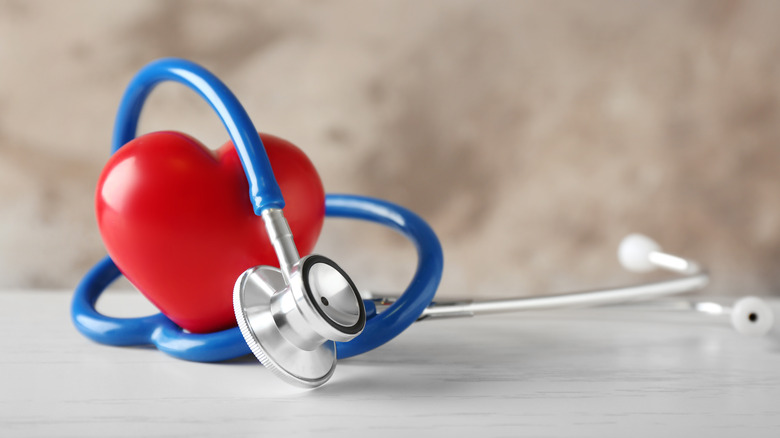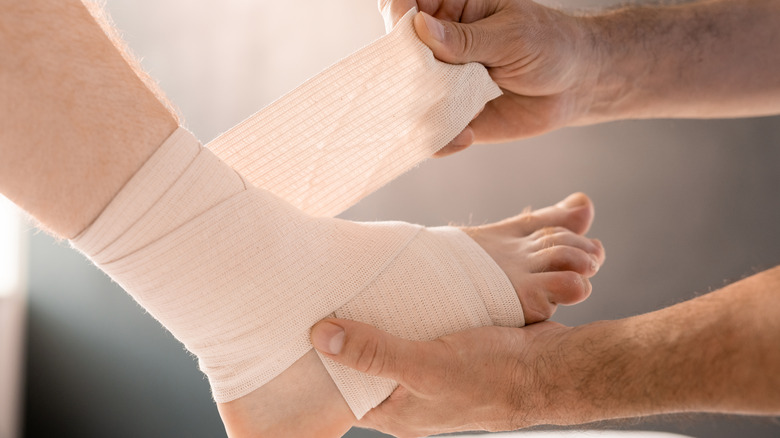Symptoms Of Clogged Arteries You Shouldn't Ignore
Your arteries have something in common with a bathroom sink — bear with us here. Normally, you probably don't give much thought to the sink in your bathroom. It's just there waiting to help with basic hygiene like brushing your teeth and washing your hands and face. Yes, we all take it for granted — until the drain gets clogged. But while there are simple ways to help fix a clogged sink drain (running hot water, using a plunger, chemicals, etc.), clogs in your arteries can be a serious health problem and much more complicated.
According to the Cardiovascular Institute of the South, sometimes the arteries in your body accumulate plaque, which is made of fatty deposits and cholesterol. If this happens, arteries can become narrower, making it harder for blood to flow through them. In addition, plaque can make the arteries less flexible and thicker, which also affects how blood circulates. And, yes, this buildup of plaque and its impact on the arteries — a condition known as atherosclerosis — can be dangerous. In fact, ignoring possible signs of clogged arteries could result in stroke, heart attack, or even losing a limb.
The good news is there are medications and lifestyle changes that can help someone with atherosclerosis lower their chances of developing serious health problems (via the Cardiovascular Institute of the South). So, being aware of some of the symptoms of clogged arteries is important and shouldn't be ignored — address your symptoms with your health care professional and develop a course of action.
Chest pain
There's no denying chest pain can be a sign that someone is having a heart attack. However, there are other reasons you could feel pain in that area of your body. As MedlinePlus explains, sometimes chest pain occurs because the body is having trouble circulating blood through the vessels that supply blood to your heart. This condition is known as angina, and when not enough blood and oxygen are circulated to the heart, you can experience unstable angina.
Okay, but what does any of this have to do with clogged arteries? Well, to answer that, it's important to keep in mind that the blood vessels that supply blood to the heart are called the coronary vessels (per MedlinePlus). And when a person has plaque buildup in these vessels (aka when they develop atherosclerosis), the coronary vessels can become injured and diseased (via the Mayo Clinic). This condition is called coronary artery disease, and while atherosclerosis isn't the only reason someone might develop it, odds are high that they'll experience unstable angina if they have coronary artery disease because of clogged arteries.
While angina isn't the same thing as a heart attack, a person is more likely to have a heart attack if they experience unstable angina, according to MedlinePlus. So, if you or someone you know suddenly experiences severe chest pain that seems to come out of nowhere, call 911.
Changes in vision
There are many reasons why someone's vision might become blurry, including they could need a new prescription for eyeglasses or contacts. With that said, changes in vision can be red flags of a retinal artery occlusion, via MedlinePlus.
Before we go any further, let's take a step back and talk about the part of your eyes known as the retina. As MedlinePlus explains, the retina is located in the back of your eye and is crucial for vision. And like other parts of your body, your retina has arteries (retinal arteries). Unfortunately, these arteries can get blocked by fat deposits, for example, and the chances of this happening go up if a person has atherosclerosis. In addition, blood clots can also obstruct blood flow through the retinal arteries, especially if they're already clogged and compromised due to atherosclerosis. Regardless, this blockage is what's known as retinal artery occlusion.
Of course, if blood cannot flow properly to the retina, that can affect your eyesight. According to MedlinePlus, a person with retinal artery occlusion can develop blurry vision in either part of one of their eyes or the entire eye. They also might experience partial or complete loss of vision in that eye. And while vision changes due to blocked blood flow through the retinal arteries can be temporary — sometimes only lasting a few seconds — it also can be permanent.
Cramps while walking
Imagine this: You're walking with your friend when suddenly they get a cramp in their leg. You help them to a bench, and the cramp seems to get better. However, as soon as you both begin walking again, the cramp returns. Unfortunately for your friend, this cramping could be a sign of clogged arteries.
According to the Cleveland Clinic, cramps that happen in legs when walking can be a red flag of atherosclerosis. In fact, this type of cramping has a name: intermittent claudication. Specifically, if a muscle experiences claudication, then it's not getting enough blood during exercise (per the Mayo Clinic). And while clogged arteries can lead to cramping in the legs, claudication can also cause pain in the feet, hips, and buttocks. In addition, claudication can occur in the upper half of your body — biceps, forearms, and shoulders, for instance — although this isn't as common.
So, how can you tell the difference between intermittent claudication and regular leg cramps? Well, it can be a little tricky. As the Mayo Clinic explains, usually intermittent claudication goes away when you rest (hence, the intermittent part of its name). However, if you don't properly address claudication, that pain might still be present even if you stop walking or working out. The bottom line is if you're experiencing intermittent pain in your legs or pain that won't go away, you might want to contact your health care professional.
Shortness of breath
Picture this scenario: You're on the 20th floor of a building when the fire alarm starts blaring. Since you can't use the elevator, you start running down all 20 flights as fast as you can. By the time you reach the ground floor, you'll likely have some trouble catching your breath. But while intense physical activity can cause shortness of breath, so too can health concerns, including clogged arteries.
Remember, a person can develop coronary artery disease because of plaque buildup in the vessels that deliver blood directly to the heart (per the Metropolitan Cardiovascular Consultants). When these arteries become clogged, it can lead to a type of chest pain known as angina. And although it's not very common, being short of breath following physical activity can be a symptom of angina. In other words, breathing issues might be red flags of coronary artery disease.
Of course, since the coronary arteries are so important to the heart, it's not surprising that a person with coronary artery disease and angina is at higher risk of having a heart attack, according to the Metropolitan Cardiovascular Consultants. After all, a heart attack happens when the heart doesn't get the necessary amount of nutrients and oxygen from the bloodstream — something that could definitely occur as a result of clogged coronary arteries. And yes, shortness of breath is a potential symptom of a heart attack, especially for women.
Heart palpitations
When you hear the term "clogged artery," do you think about an artery that is completely sealed off? If you said "yes," it's understandable, but it's important to keep in mind that arteries can still be problematic even when they're only partially clogged. For example, according to WebMD, you could experience heart palpitations even if you have an artery that's blocked up by only 70%.
Now, you've probably heard of heart palpitations, but just to make sure we're all on the same page, heart palpitations can feel different from person to person. As WebMD explains, someone might describe a heart palpitation as their heart fluttering. Another person might say their heart keeps "skipping a beat." And still, you might describe it as your heart racing or pounding hard. And your chest isn't the only place you might experience heart palpitations. Even though the chest is where the heart is located, you could feel heart palpitations in your neck or throat.
While heart palpitations can be a signal that you have clogged arteries, they can specifically be warnings of coronary artery disease (via WebMD). In addition, heart palpitations could be connected to issues with the heart itself, like a problem with one of your heart's valves. And they can precede a heart attack. However, palpitations can also occur because of stress and diet. So, if you're experiencing heart palpitations and aren't sure why, contact your health care professional.
Lower back pain
Unfortunately, this next potential symptom of clogged arteries can be easy to miss. As Johns Hopkins explains, there's only five vertebrae in your lower back, and they carry the weight of the entire upper part of the body. So, lower back problems and pain are fairly common, making it sometimes less obvious when clogged arteries are a factor.
According to the Physicians Committee for Responsible Medicine, not only can arteries be responsible for supplying blood to the lower back experience clogging, but they also can be one of the first types of arteries to become clogged. As a matter of fact, clogged arteries can lead to less blood circulating to the parts of the spine located in the lower back. And this can set off a domino effect where the discs that act as padding between the vertebrae become weakened, which can lead to back issues like pinched nerves and herniated discs.
Besides clogged arteries, you might also experience pain in your lower back via "strenuous physical activity" or even if you're sedentary (via Johns Hopkins Medicine). Also, smoking and obesity can increase the odds of back pain. The point is if you have lower back pain, don't shrug it off as an inevitable part of life. A health care professional might be able to help you, including determining if clogged arteries are the cause.
Fatigue
In the series finale of "How I Met Your Mother," Barney (Neil Patrick Harris) becomes a father and, at one point, is extremely tired because his baby wouldn't sleep. But despite Barney's difficulty staying awake while he's out with his friends, he's not technically fatigued. This is because his tiredness will go away once he gets some rest. However, the kind of fatigue that points to clogged arteries and kidney problems won't just disappear with a good night's sleep.
Just like how your heart has the coronary arteries, according to Stanford Health Care, your kidneys have the renal arteries, which can develop atherosclerosis. Remember, when atherosclerosis occurs, plaque accumulates inside the arteries — and in the case of the renal arteries this can lead to chronic kidney disease. As the National Institute of Diabetes and Digestive and Kidney Diseases explains, chronic kidney disease is when the kidneys are no longer able to properly filter the bloodstream. This is the equivalent of a sanitation worker not picking up all the garbage. After a while, that trash will begin piling up and causing problems. The same thing happens to the wastes in your body when your kidneys are unable to do their job.
Although unexplainable exhaustion can be a warning sign that not only are your renal arteries clogged, but also your kidneys are becoming damaged — it's not the only potential red flag of kidney disease, though. Besides fatigue, other symptoms of kidney disease include feeling itchy and nauseous (per Stanford Health Care).
Numbness
Before we explore this next possible indicator of clogged arteries, we need to talk about the carotid arteries. As the UC Davis Health explains, these arteries not only supply blood to the neck and face but also to specific areas of your brain. When these arteries become compromised, that can negatively affect your sense of touch, as well as ability to think, move, and speak.
Unfortunately, not only can plaque accumulate inside the carotid arteries, but plaque can also break off, travel through the bloodstream, and clog up these arteries where they branch off (via UC Davis Health). And this compromised blood flow can result in a transient ischemic attack (TIA), which is also called a "mini-stroke." But don't let the "mini" part fool you. If a person experiences a TIA, they'll have a loss of brain function, albeit temporarily. Plus, a TIA could be what precedes a stroke where the person will experience a permanent loss of brain function.
Yes, there can be a chain reaction where clogged carotid arteries lead to a TIA followed by a stroke, according to UC Davis Health. And a potential sign of a TIA is sudden numbness. In particular, a person experiencing a "mini-stroke" might say that one side of their face feels numb. Or they might go numb in one arm or one leg. Usually, if it's a TIA, this numbness will be on one side of the body. If this happens, called 911 immediately.
Hair loss on legs and feet
Hair loss on your legs can be warning you of clogged arteries. As the Mayo Clinic points out, atherosclerosis can go hand in hand with PAD (peripheral artery disease or peripheral arterial disease). This health problem specifically involves the arms and legs, although most people will experience it in their legs. In a nutshell, when the arteries become narrower, your limbs receive less blood flow. And, yes, this can cause a type of cramping called claudication, which we talked about earlier in this article. However, in addition to claudication, you might notice either you have less hair on your legs and feet or the hair you do have is growing more slowly than usual.
Although altered and reduced hair growth can be a sign of PAD and clogged arteries, that's not the only potential telltale sign of these conditions. According to the Mayo Clinic, you might also notice your toenails growing at a slower rate if you have PAD. And there might be changes in the color of your legs. Additionally, PAD could make the skin on your legs shiny.
Nausea
Clogged arteries in any part of your body has the potential to cause harm. However, as Verywell Health points out, clogs in the arteries responsible for making sure your heart gets the right amount of blood — the coronary arteries — can be especially dangerous. And not only is nausea a possible red flag of clogged arteries, it can also mean someone is experiencing a medical emergency (per the Cleveland Clinic).
Since coronary arteries are so crucial for the heart to function properly, it's not surprising that coronary artery disease (CAD) can be detrimental to your heart, according to Verywell Health. And because blood cannot flow normally through arteries affected by CAD, the heart cannot receive the right amount of oxygen and nutrients it needs. As a result, a person with CAD can experience a heart attack (via the CDC). And although chest pain is often the first symptom people think of regarding heart attacks, nausea can also be a warning sign. Additionally, you might have indigestion and even vomit if you're experiencing a heart attack.
Of course, nausea can occur for reasons besides a heart attack. In fact, it can also just be a symptom of CAD (per the CDC). And, of course, feeling nauseous might be because of something you ate. However, don't be afraid to seek medical help, especially if you think your nausea might be signally a health problem like CAD.
Sores
Often, we think of ulcers happening in the stomach. However, as Healthline states, ulcers can also happen on the surface of your skin. And not only can arteries be the culprit behind these open sores, but clogged arteries are typically the issue causing arterial ulcers.
Remember, your arteries aren't only responsible for supplying blood to your organs but also your tissues, including the tissues that make up your skin (per Healthline). But if your arteries are damaged and/or clogged, they can't properly get that blood to (in this case) your skin. This is why clogged arteries can lead to arterial ulcers — sometimes called ischemic ulcers. In particular, someone might notice these ulcers on their legs and specifically ankles. You also might find them on different parts of your feet, such as toes or heels. And make no mistake, ulcers caused by artery-related health problems are painful. In fact, someone with these types of ulcers is more likely to experience pain in their legs at night.
Other possible signs of arterial ulcers include the color of the sores, which can be yellow, black, or red, according to Healthline. The ulcers might go deep into the skin and yet not bleed. Also, the part of the body that has the ulcer might be cooler to the touch than other parts of the body. This is because blood is not circulating properly. In addition, hair loss is another symptom on this list, and it can occur with arterial ulcers.
Cold hands
The phrase "cold hands, warm heart" means a person with cold hands is kind and loving. While this is a nice idea, cold hands can be a sign of a disorder known as Raynaud's syndrome (per the Cleveland Clinic). And if you guessed there's a connection between Raynaud's and clogged arteries, you're absolutely correct.
Now, before anyone panics, having cold hands isn't necessarily a bad thing. As a matter of fact, your body's response to cold weather, for instance, is to constrict muscles as a way of keeping your organs safe and conserving heat, via Cleveland Clinic. The reason why your hands feel colder during this process is because muscles tighten around the radial and the ulnar arteries, which both supply blood to your hands. But a person with Raynaud's experiences narrower or constricted blood vessels, which can affect blood flow to different areas of the body. And atherosclerosis is not only a possible cause of a form of this disease — known as Secondary Raynaud's disorder — but also one of the most common reasons behind this type of Raynaud's syndrome.
In addition to Secondary Raynaud's disorder, a symptom of peripheral artery disease or PAD is cold hands, according to the Cleveland Clinic. Remember, plaque accumulation in the arteries is a hallmark of PAD. And one more important note: A person with peripheral artery disease can also experience coldness in their feet.
Severe headache
Since headaches are very common, it can be frightening to think about how a severe headache could be a warning sign of a stroke (per RadiologyInfo.org). But while it's highly unlikely that every time you feel a pain in your head it's a red flag of something dangerous, it's still important to be aware of the possible connection between a severe headache, stroke, and clogged arteries.
According to RadiologyInfo.org, there are two different types of strokes: hemorrhagic and ischemic. While a hemorrhagic stroke involves a blood vessel that's located in the brain either breaking or rupturing, an ischemic stroke occurs because of a blood vessel like an artery that supplies blood to the brain becoming narrowed or blocked. And while blood clots can cause strokes, so too can arteries that are clogged with plaque. Of course, not everyone who has a stroke will experience a headache, but there are some common warning signs when it comes to this potential sign of a stroke. While some headaches come on gradually, stroke-related headaches usually happen suddenly and are extremely painful.
Besides a severe headache, other potential signs of stroke include vision problems that might only impact one eye, lack of coordination and balance, numbness on either the right or the left side of the body, and problems speaking (via RadiologyInfo.org). Whether or not clogged arteries are behind a stroke, it's crucial to call 911 immediately even if you only suspect someone is having a stroke.
Excessive sweating
It's very common to sweat while exercising, especially during an intense workout. But if you have clogged arteries, your body might be "working out" all the time, which can cause you to sweat excessively.
Remember, your heart is a muscle, but unlike the ones in your arms and legs, it's constantly contracting so it can pump blood throughout your body. However, as Healthline points out, clogged arteries make it more difficult for your heart to circulate your blood. This means it has to work harder, which has the potential to raise your body's temperature. Sweating and sometimes excessive sweating keeps your temperature from going up, which is good for avoiding other complications that can occur from an elevated body temperature but doesn't address the underlying cause.
The bottom line is excessive sweating can happen because of clogged arteries forcing your heart to work harder, and that additional strain can eventually lead to a heart attack (via Healthline). In addition, while night sweats can be a sign of menopause, it also can be a red flag of heart problems and even a heart attack. But if you think you're having a heart attack, don't attempt to drive yourself to a health care professional or hospital. Instead, call 911. And even if you aren't at high risk for a heart attack, you should still have handy a list of any medications, vitamins, and supplements you're taking in case of an emergency.














